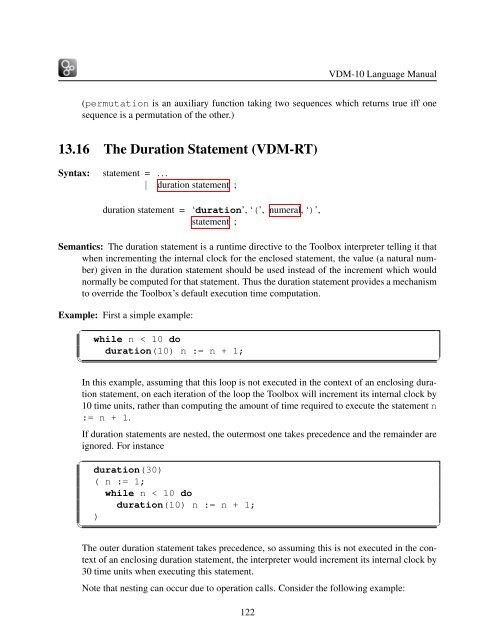VDM-10 Language Manual
VDM-10 Language Manual
VDM-10 Language Manual
You also want an ePaper? Increase the reach of your titles
YUMPU automatically turns print PDFs into web optimized ePapers that Google loves.
<strong>VDM</strong>-<strong>10</strong> <strong>Language</strong> <strong>Manual</strong><br />
(permutation is an auxiliary function taking two sequences which returns true iff one<br />
sequence is a permutation of the other.)<br />
13.16 The Duration Statement (<strong>VDM</strong>-RT)<br />
Syntax: statement = . . .<br />
| duration statement ;<br />
duration statement = ‘duration’, ‘(’, numeral, ‘)’,<br />
statement ;<br />
Semantics: The duration statement is a runtime directive to the Toolbox interpreter telling it that<br />
when incrementing the internal clock for the enclosed statement, the value (a natural number)<br />
given in the duration statement should be used instead of the increment which would<br />
normally be computed for that statement. Thus the duration statement provides a mechanism<br />
to override the Toolbox’s default execution time computation.<br />
Example: First a simple example:<br />
✞<br />
✡✝<br />
while n < <strong>10</strong> do<br />
duration(<strong>10</strong>) n := n + 1;<br />
✆<br />
In this example, assuming that this loop is not executed in the context of an enclosing duration<br />
statement, on each iteration of the loop the Toolbox will increment its internal clock by<br />
<strong>10</strong> time units, rather than computing the amount of time required to execute the statement n<br />
:= n + 1.<br />
If duration statements are nested, the outermost one takes precedence and the remainder are<br />
ignored. For instance<br />
✞<br />
✡✝<br />
duration(30)<br />
( n := 1;<br />
while n < <strong>10</strong> do<br />
duration(<strong>10</strong>) n := n + 1;<br />
)<br />
The outer duration statement takes precedence, so assuming this is not executed in the context<br />
of an enclosing duration statement, the interpreter would increment its internal clock by<br />
30 time units when executing this statement.<br />
Note that nesting can occur due to operation calls. Consider the following example:<br />
122<br />
✆
















